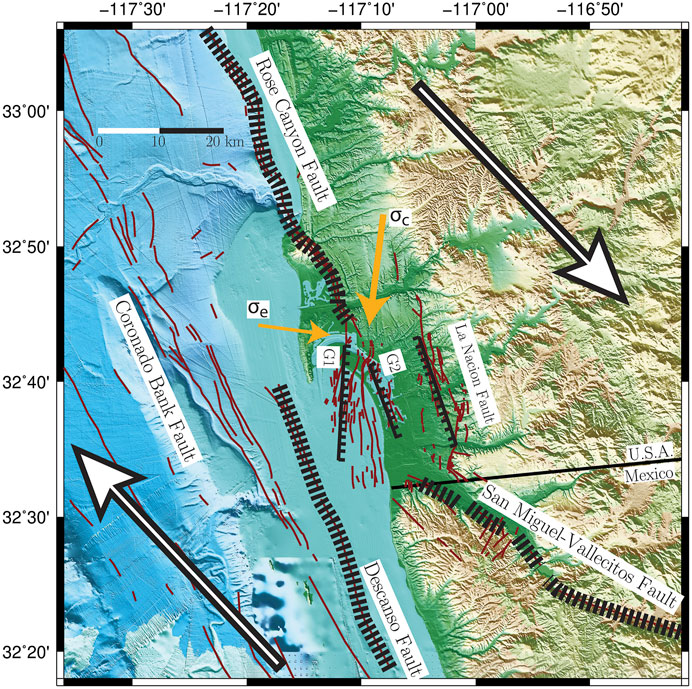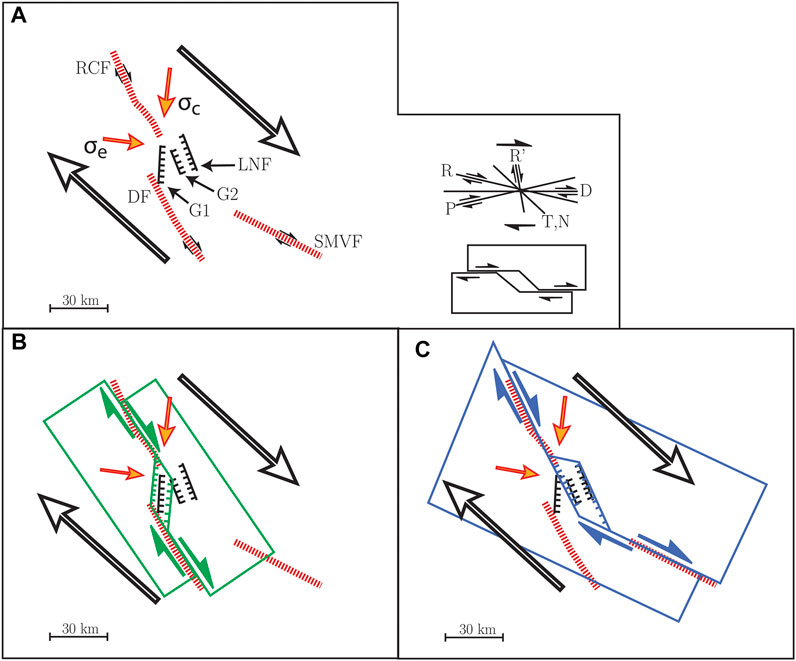- 1Department of Geological Sciences, San Diego State University, San Diego, CA, United States
- 2Scripps Institution of Oceanography, University of California, San Diego, San Diego, CA, United States
- 3Pacific Coastal and Marine Science Center, U.S. Geological Survey, Santa Cruz, CA, United States
- 4Department of Earth and Ocean Sciences, University of North Carolina, Wilmington, NC, United States
A Corrigendum on
Recency of Faulting and Subsurface Architecture of the San Diego Bay Pull-Apart Basin, California, USA
by Singleton D. M., Maloney J. M., Brothers D. S., Klotsko S., Driscoll N. W., and Rockwell T. K. (2021). Front. Earth Sci. 9:641346. doi: 10.3389/feart.2021.641346
In the published article, there was an error that appears in Figures 13, 14, 15B. In these figures, the arrow used to depict the North American-Pacific plate motion vector had an incorrect orientation, which was inconsistent with descriptions in the text. The corrected Figures 13–15 appear below.

FIGURE 13. Regional fault orientations and plate boundary parameters used for kinematic analysis and interpretation. Solid orange arrows are maximum and minimum horizontal stress orientations,

FIGURE 14. Conceptual model for San Diego Bay pull-apart basin. (A) Model parameters, see Figure 13 for explanation. (B) Conceptual model for Group-1 faults in a Rose Canyon-Descanso fault stepover. (C) Conceptual Model for Group-2 and La Nacion faults in a Rose Canyon-San Miguel-Vallecitos fault stepover. RCF, Rose Canyon fault; DF, Descanso fault; SMV, San Miguel-Vallecitos fault; G1, Group 1; G2, Group 2; LNF, La Nacion fault zone.

FIGURE 15. (A) Conceptual kinematic block model for the San Diego region. See section “DISCUSSION” for full model explanation. Block A, B, and C are separated by master strike-slip segments (RCF, DF, and VF) with a region of complex faulting located at their intersection beneath San Diego Bay. (B) Magnetic anomaly data of North America (Bankey et al., 2002). Master strike-slip faults in conceptual block model, particularly the San Miguel-Vallecitos fault, appear to correlate with regional low magnetic anomalies in the otherwise continuous magnetic high associated with the Peninsular Range Batholith. This may be an indication that these faults follow pre-existing weaknesses or delineate terrane boundaries that are responding to the regional strain field. (C) Map of San Diego Bay showing gravity contours from Marshall (1989). Gravity contours (solid black lines) are in mGal and show a potential gravity low in south San Diego Bay. Fault traces (thin red lines) are from USGS (2019) north of the United States-Mexico border and Fletcher et al. (2014) south of the border. Master strike-slip segments are RCF, Rose Canyon fault, DF, Descanso fault, VF, Vallecitos fault, SMVF, San Miguel-Vallecitos fault. Background topography and bathymeter are from ESRI topography and the National Centers for Environmental Information Southern California Coastal Relief Model (v2) (Calsbeek et al., 2013).
The authors apologize for these errors and state that they do not change the scientific conclusions of the article in anyway. The original article has been updated.
Publisher’s Note
All claims expressed in this article are solely those of the authors and do not necessarily represent those of their affiliated organizations, or those of the publisher, the editors and the reviewers. Any product that may be evaluated in this article, or claim that may be made by its manufacturer, is not guaranteed or endorsed by the publisher.
Keywords: pull-apart basin, fault structure, marine paleoseismology, newport-inglewood-rose canyon fault system, inner California continental borderland, San Diego bay
Citation: Singleton DM, Maloney JM, Brothers DS, Klotsko S, Driscoll NW and Rockwell TK (2021) Corrigendum: Recency of Faulting and Subsurface Architecture of the San Diego Bay Pull-Apart Basin, California, USA. Front. Earth Sci. 9:814080. doi: 10.3389/feart.2021.814080
Received: 12 November 2021; Accepted: 15 November 2021;
Published: 02 December 2021.
Approved by:
Frontiers Editorial Office, Frontiers Media SA, SwitzerlandCopyright © 2021 Singleton, Maloney, Brothers, Klotsko, Driscoll and Rockwell. This is an open-access article distributed under the terms of the Creative Commons Attribution License (CC BY). The use, distribution or reproduction in other forums is permitted, provided the original author(s) and the copyright owner(s) are credited and that the original publication in this journal is cited, in accordance with accepted academic practice. No use, distribution or reproduction is permitted which does not comply with these terms.
*Correspondence: Drake M. Singleton, ZHNpbmdsZXRAdWNzZC5lZHU=
†Present address: Drake M. Singleton, Pacific Coastal and Marine Science Center, U.S. Geological Survey, Santa Cruz, CA, United States
 Drake M. Singleton
Drake M. Singleton Jillian M. Maloney
Jillian M. Maloney Daniel S. Brothers3
Daniel S. Brothers3 Shannon Klotsko
Shannon Klotsko Thomas K. Rockwell
Thomas K. Rockwell